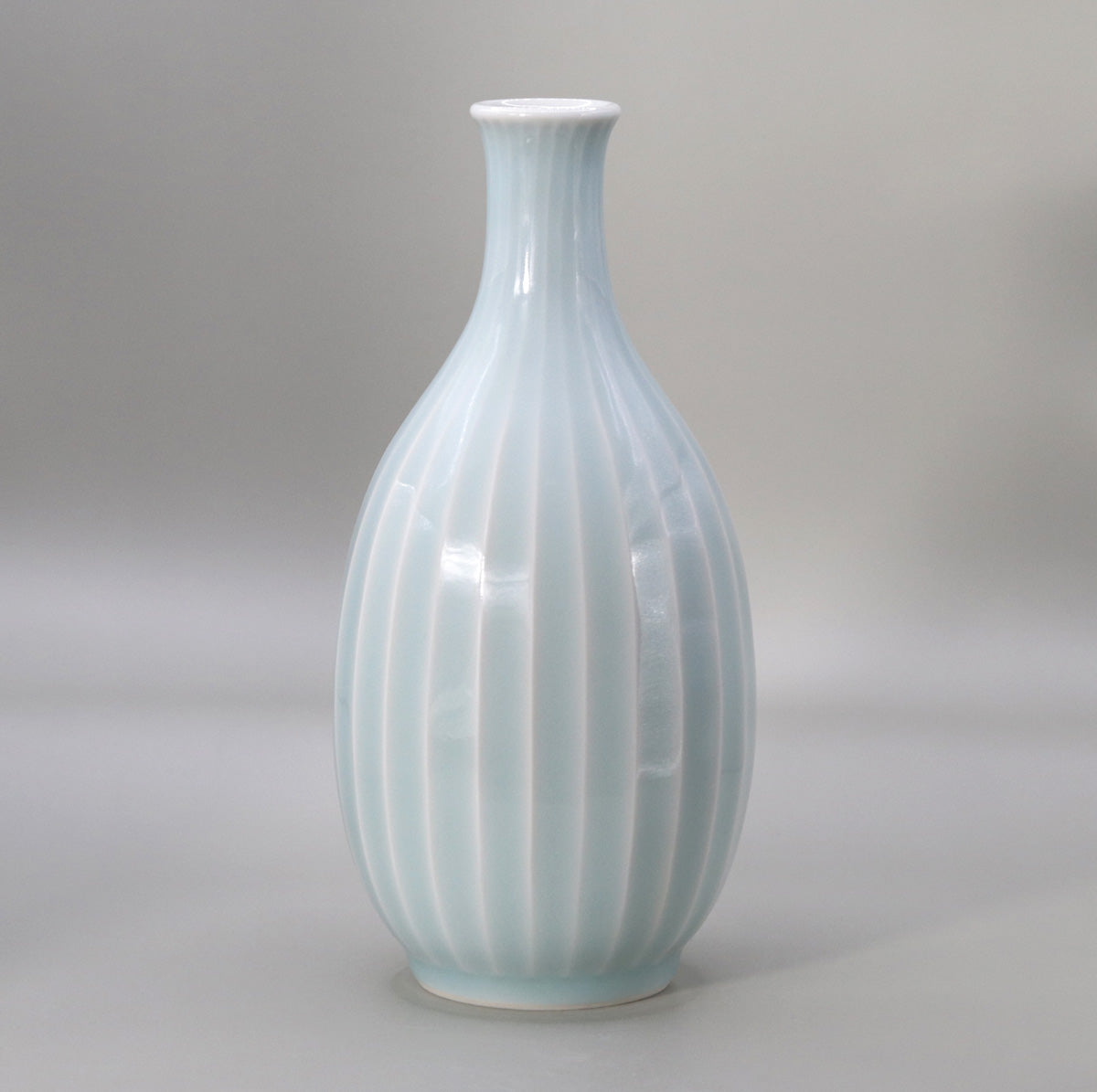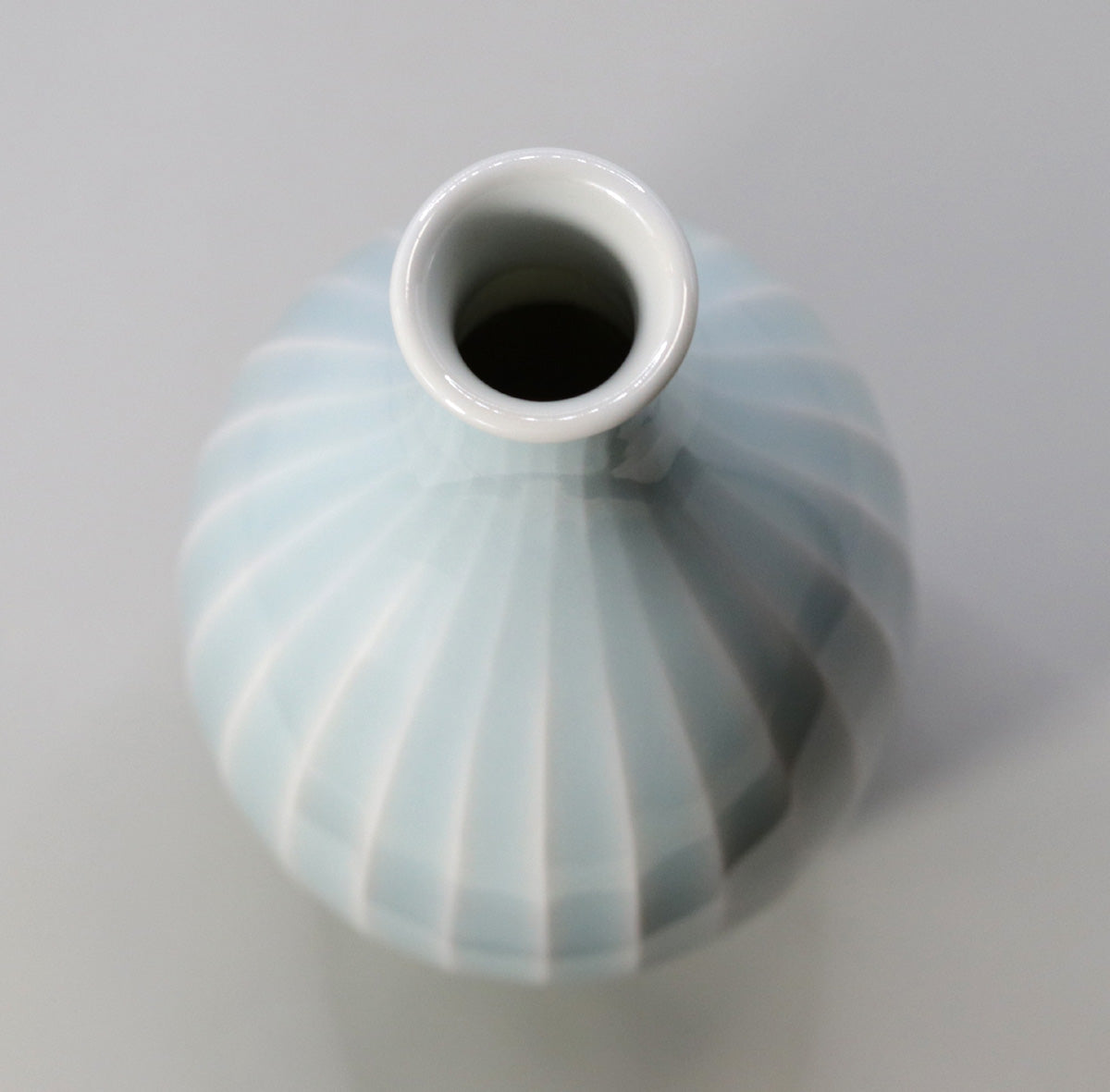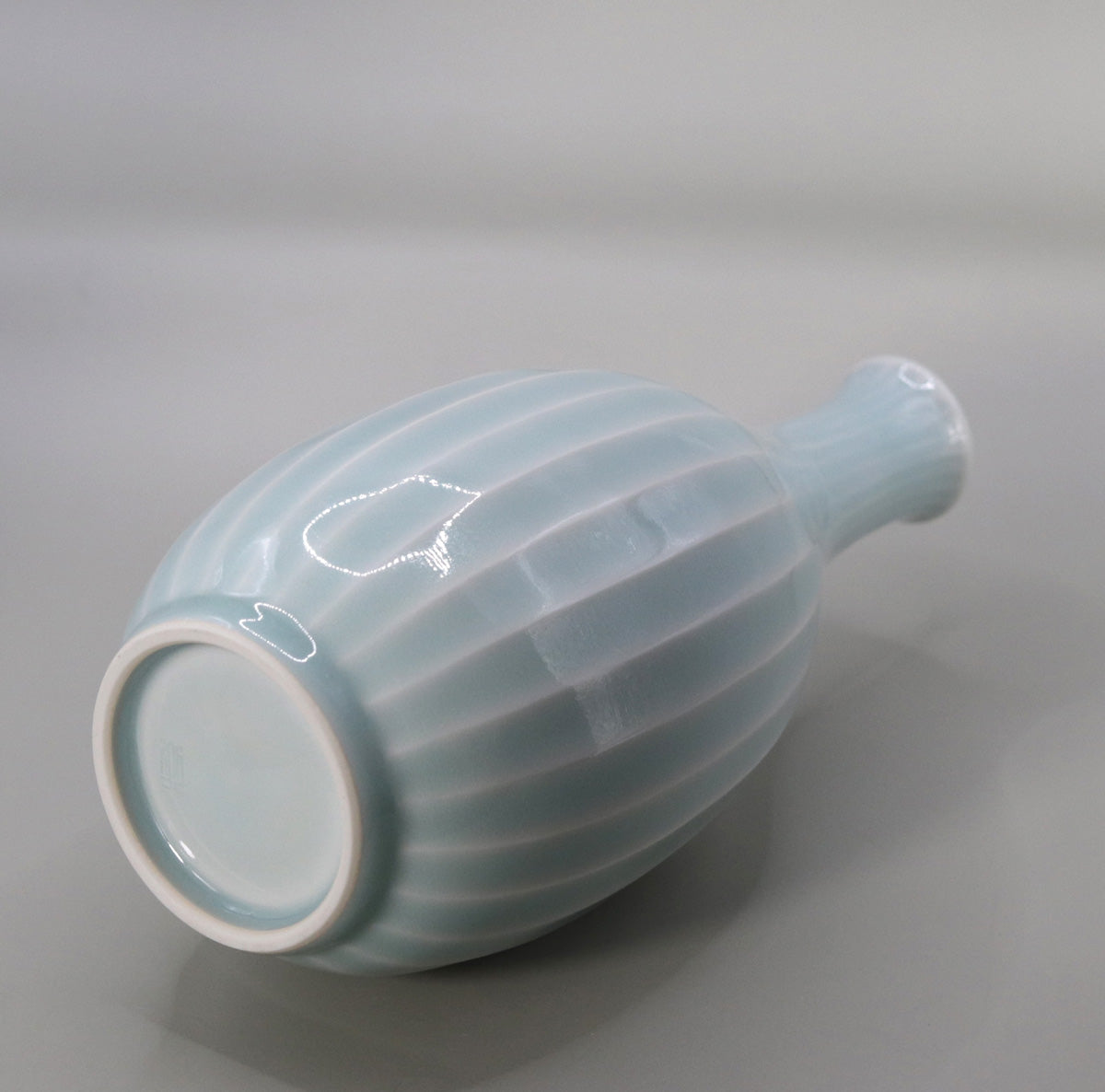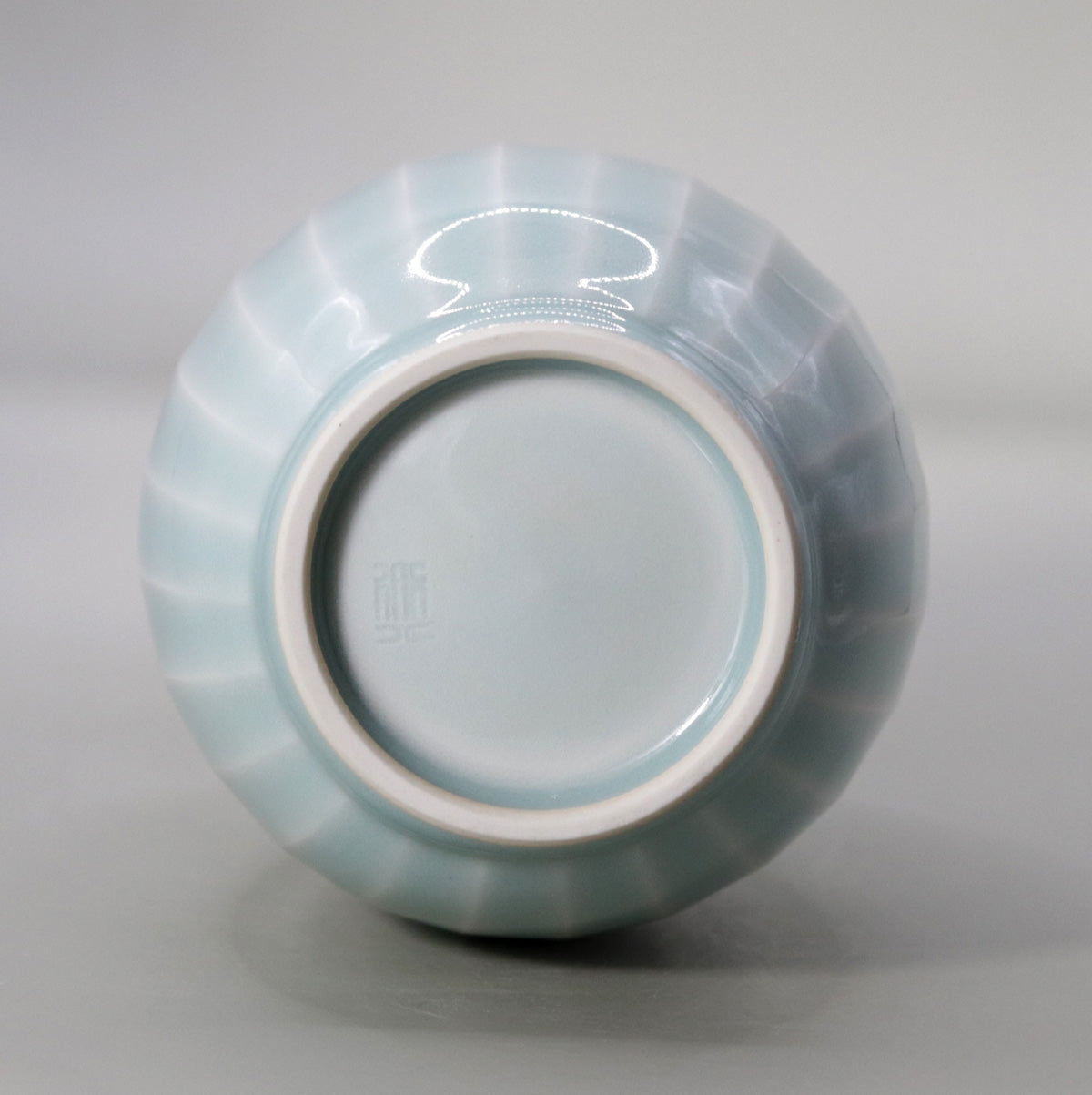Celadon Flower Vase (Shinogi) by Dohachi Takahashi
Celadon Flower Vase (Shinogi) by Dohachi Takahashi
Couldn't load pickup availability
Width: 9.75cm Height: 20.3cm
Celadon vase - Takahashi Michihachi IX
The slightly hazy celadon glaze gives off a cool and dignified feeling, and the vertically engraved ridges of the porcelain create soft shadows in the light. This vase is the fruition of the unique sculptural sense and advanced celadon techniques of the ninth generation Takahashi Michihachi. Below, we will introduce the charm and background of this vase in detail from five perspectives.
1. Beauty of form - the rhythm of curves and ridges resembling drops of water
The continuous curves that run from the rim to the body are reminiscent of the moment when a drop of water falls quietly and swells into a teardrop shape. The body is evenly ridged, and the vertical shadows give it a firmer form. The proportions that taper slightly towards the base combine stability and lightness, and when placed on a table, the eye is drawn to the top, making the flowers placed inside stand out.
2. Glaze Tone - Ice Blue Veil and Eggshell Border
The celadon glaze is made from a mixture of feldspar containing very small amounts of iron, and is reduced firing to produce a pale blue color reminiscent of ice. A thin layer of glaze pools on the ridges of the porcelain, allowing the white porcelain base to show through slightly, revealing an eggshell border that changes appearance from milky white to silvery white depending on the angle of the light. This difference in nuance brings out the emerald color and shadow blue that are unique to celadon in a three-dimensional way.
3. Design - Shinogi's design of the Hobby of Fine Bottles
The ridged pattern is a design seen on Chinese Song Dynasty porcelain bottles and Goryeo celadon ware, introduced in the Kamakura period, and is also known as the "water vessel" because the continuous ridges are reminiscent of ripples on the surface of water. In this piece, the ridges are not carved deeply, leaving them gently rounded, achieving both the softness of the celadon glaze and modern simplicity. The flower is the main focus, and the vessel quietly recedes into the background - this design exudes the spirit of wabi.
4. Techniques - The art of wheel-throwing and uniform cutting
After carefully turning the clay on a potter's wheel, carving out the ridges evenly while it is still semi-dry requires delicate techniques to minimize unevenness in thickness. After bisque firing, the piece is dipped in a finely adjusted glaze and the firing temperature is carefully controlled while switching between oxidation and reduction to achieve a clear glaze that does not run off the ridges. The high level of skill in kiln work that the ninth generation has cultivated is condensed in this clear color and uniform luster.
5. Historical and cultural background: The inheritance of celadon and ridged patterns
Celadon originated in the Ru kilns and official kilns of the Northern Song Dynasty in China, and was incorporated into the tea ceremony in Japan along with the reverence for Chinese goods from the Kamakura to Muromachi periods. Ridged patterns are also used on the porcelain bottles and sutra containers revered in Zen temples, and are beloved by high priests and tea masters as symbols of purity and mystery. Takahashi Dohachi IX, known as a master of Kyoto ware color painting, also studied Chinese Yi Dynasty celadon, achieving a refined design that stands out in modern tea rooms and living spaces. This vase, which reinterprets traditional design with a modern minimalism, is the culmination of his studies and aesthetic sense.
The Takahashi Dohachi family has been known as a prestigious Kyoto ware color painting family since the late Edo period. The ninth generation master graduated from the Department of Clothing Design at Kyoto Bunkyo Junior College, majored in design, and then went on to the Department of Molding and Research at Kyoto Prefectural Ceramic Technical College, and further solidified his technical foundation at the Kyoto Industrial Research Institute.
In 1996, he began to study pottery under his father, Dohachi Yashiro, and began making pottery in earnest.
In 2012, he took on the name of the ninth Takahashi Dohachi.
His style, which combines the sense of form cultivated in clothing design with the traditional techniques of Kyoto ware, has breathed new life into the Dohachi family of pottery and displays a sophistication that stands out in modern tea ceremonies and gallery spaces.
This vase, with its pale blue glaze and the ridges of white porcelain showing through, is a "quiet vessel" that, while containing a cool moisture, gently brings out the vitality of the flowers with the rhythm of the ridges. The narrow mouth allows the flowers to gather naturally, making it easy to define the shape of a single flower or a branch, neatly depicting the changing of the seasons. If you put neat flowers such as daffodils for New Year, dewdrops in summer, or lady's mantles in autumn in it, the cool texture of the celadon will double the freshness of the flowers. We hope you will enjoy using this vase for many years to come, and enjoy the changes that occur over time as the celadon glaze deepens its dialogue with the unbleached base, as well as the outstanding beauty of Takahashi Michihachi's sculpture.
Share








Multi-Column
-
[I will send it to you quickly and carefully]
We carefully package each product in a way that suits it best.
Also, delivery times vary depending on the piece (vessel, etc.).
Items that already come with a box will be shipped within 1-3 days of the order date.
For items that require a box to be made after your order, it will take approximately 30 days for production to be completed and then shipped.
In either case, once we have confirmed your order, we will contact you by email to inform you of the delivery date.
-
[Requests when purchasing pottery]
Even products that look the same may differ slightly in color, shape, size, etc.
The way the glaze is used, the power of the kiln, the firing method, the season, and the humidity also affect the appearance of the pottery.
Please understand the individuality of each piece of pottery and enjoy the unique warmth of handmade.








